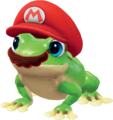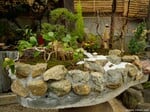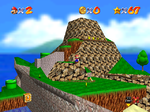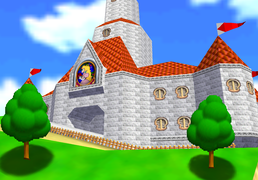User:Nintendo101
Casual Nintendo historian. Otherwise an artist and a field ecologist. Bio degree. I've had an account here since 2012.
I wrote the character sections for Super Mario 64, Super Mario Galaxy 2, and Super Mario Odyssey. I contributed much of the article for Super Mario Galaxy and Super Mario Sunshine.
I have been a fan of Nintendo since a very young age. My first Mario games (and three of the first video games I ever owned) were Super Mario World: Super Mario Advance 2, Super Mario 64 DS, and Mario Kart DS. These games were good company for a young kid who moved around a lot and had difficulty keeping long-lasting friends.
During the COVID-19 pandemic, I sequentially played some of my favorite games in the Super Mario series to 100% completion. This includes, in order, Super Mario Bros., Super Mario Bros. 2, Super Mario Bros. 3, Super Mario World, Super Mario World 2: Yoshi's Island, Super Mario 64, Super Mario Sunshine, Super Mario Galaxy, Super Mario Galaxy 2, Captain Toad: Treasure Tracker, and Super Mario Odyssey. It's been really fun! These are great games, and I always wanted to marathon a series like this before but never had the time. It has been interesting to see where the series began and where it has ended up. The design philosophies, the characters, the art directions, world building, level design, narrative, etc. All good stuff. It might be fun to write something about it some day.
My favorite video game character is Yoshi.
Sandbox for current project
Setting
Super Mario 64 takes place within the walls of Princess Peach's castle in the Mushroom Kingdom. It is the first Super Mario game to explicitly include the Mushroom Kingdom as a location since Super Mario Bros. 3 (1988). The game's levels, called "courses", are not naturally occurring places on Mario's world. They were created by Bowser using the Power Stars he stole from Peach. Most of them are accessed through paintings that hang in the castle's walls, but some are more cryptically hidden or require the player to accomplish a task in the castle before becoming accessible. Some paratextual material and subsequent titles present the courses introduced in this game as visitable places outside of the paintings.
Generally, a course is a sprawling location with interactive environmental elements and several levels of elevation. Courses often have subareas and collectibles obscured in the landscape that passively encourage the player to rotate the camera and explore. Most courses feature prominent landmarks, such as the mountain in Bob-omb Battlefield or the volcano in Lethal Lava Land, that provides the player with a consistent point of reference that mitigates their chance of getting lost.[1] Like its more immediate predecessors, courses are themed after real-life ecosystems (i.e. deserts, mountains, seas) and more fantastical settings (i.e. haunted houses, clock towers, rainbow roads in the sky). The theme informs the type of objects that can be interacted with in the level; the types of enemies that can be encountered; and the non-playable characters that can be spoken to. For example, cactus enemies, a condor, and quicksand are in the desert-themed Shifting Sand Land. Penguins, slippery ice, and deep snow appear in Cool, Cool Mountain and Snowman's Land. Most courses contain switches and strikable objects that modify elements of the course, such as the Crystal Taps in Wet-Dry World.
Unlike the levels of prior two-dimensional entries, the courses in this game are open-ended and largely do not funnel the player towards one goal. This was an intentional departure from the level design principals of prior games because the development team did not believe they could be replicated for a fun experience in a three-dimensional environment. Director and series creator Shigeru Miyamoto wanted Super Mario 64 to be a game where players "create their own vision", a decision partially influenced by the technical difficulty of making a precise jump in a 3D environment.[2][3][1] This mindset manifested in levels where players were largely free to interact with the world in ways they wanted to, with larger platforms and sprawling spaces that encouraged exploration rather than carryout precise actions to reach a goal. The courses themselves were created using hakoniwa or "box garden" design principals.[4][3][note 1][1][5] A hakoniwa is a intricately-arranged miniature garden within an enclosed space, with layers of depth and detail that become apparent to an onlooker when carefully examined.[6][7][5] Applying these principals allowed the development team to create complex levels that surprise players, another important tenet during development.[2][3][1] In the West, where creating miniature gardens is not as culturally prevalent, these types of levels are most often likened to sandboxes.[5]
Courses
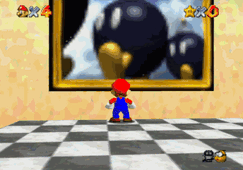
Most of the courses are accessed through paintings inside Princess Peach's Mushroom Castle, the hub world of the game. The surface of a painting ripples like water when near, and Mario is brought to the course it represents by physically jumping through it. Accessing levels in this manner is a departure from the overworld system in previous platform games (see below). However, the castle is divided into several sections that are analogous to the world structure of proceeding games, where multiple levels are available to the player on a single section and the player must complete a boss-dedicated course in order to gain access to the next one. As Mario advances through the castle, he encounters some courses that are accessed through portals other than paintings, such as Shifting Sand Land, which is accessed through what looks like a brick wall at a dead end in the basement, or Tick-Tock Clock, which is entered through a clock face. The location of courses on subsequent floors is generally more complex and are puzzles in themselves, such as the painting for Snowman's Land that is only viewable through a mirror.[8]
Rather than present a unilateral scenario that leads to a single spatially-fixed goal, most courses in the game host multiple objectives called "missions" that each have a goal in a different location from each other. For most courses, entering a painting (or equivalency) brings the player to a mission selection screen, where selecting one sends Mario to the course within the confines of the mission's specific scenario and its unique goal. In nearly all courses, this goal is a Power Star, a collectible token resembling the Super Star power-up of prior entries. Touching one completes the level and returns Mario to the castle. The number of Power Stars collected is tracked by the game and communicated to the player on the user interface in the upper right corner of the screen. Accumulating Power Stars is how new courses become accessible to the player. On the first floor, some ★ doors that seal away certain paintings only open after Mario has collected a specified number of Stars. Mario can only access a new floor after clearing the current one's Bowser course, itself only becoming accessible after a specified number of Power Stars have been obtained. However, there are 120 obtainable Power Stars in a game that only requires 70 to access the final level. The player has some discretion on how many or which ones are obtained to finish the game, as well as the order.
In most courses, one mission correlates with one Power Star, and its name on the mission selection screen hints at the Star's location in the course. However, some Power Stars can be encountered outside of their dedicated mission and collected. Some mission-dedicated Power Stars only become available to the player once they have cleared specific missions (e.g. "Footrace with Koopa the Quick" only becomes available after completing "Big Bob-omb on the Summit") or accomplish tasks outside of the paintings (e.g. striking the Cap Switch in the Cavern of the Metal Cap makes the titular power-up accessible in "Through the Jet Stream", in which it is not optional). Certain actions completed within a course permanently change elements within it regardless of the mission subsequently played. A reoccurring example are the cannons found in most courses, which Mario can enter and launch from to quickly reach distant areas or access new ones. A cannon becomes permanently available in a course after Mario has spoken to a Bob-omb Buddy, a friendly non-playable character found in every course with a cannon.
Similar to Super Mario World 2: Yoshi's Island (1995) and a departure from previous Super Mario games, there is no Time Limit in effect within courses, but there are a few cases where there is one. For example, Blue Coins only appear for a brief period of time once a Blue Coin Block is struck, and Mario must outrun Koopa the Quick in order to earn a Power Star. All power-ups in this game change Mario's form for a limited time and one cannot be brought outside of a course even if he completes it while still under its affect – another similarity to Yoshi's Island.
There are two different types of courses in Super Mario 64. They are:
- Main courses[9] that contain six dedicated missions and an unlisted 100-coin mission. Some of the dedicated missions build off of each other environmentally or narratively. (i.e. The events that transpire in the completion of one mission are reflected in the events of the subsequent mission.) However, some Power Stars can be encountered before the mission-dedicated one and can be collected, resulting in some instances where the Stars are obtained out of the intended "order". These courses are the most intricate levels in the game. Most include objects that can enable quick traversal between areas, such as cannons and Warp Points. Some courses include accessible subareas, such as the volcano in Lethal Lava Land or pyramid in Shifting Sand Land. There are 15 main courses in the game, and they are the only levels explicitly numbered and listed on the pause menu.
- Mini courses[9] that are smaller and structured more like traditional obstacle courses that emphasize precise platforming. They lack dedicated missions to select and most only contain one Power Star. Power Stars obtained in mini courses are counted together as "Secret Stars" on the pause menu. Mini courses can further be classified into three subtypes. As detailed below, they are:
- "Bowser courses" that lead to an arena where Mario must defeat Bowser. Each Bowser course features a Power Star obtained by collecting eight Red Coins, but this does not complete the level. In the first two courses, defeating Bowser awards Mario with a Big Key, a different kind of token that completes the level when touched. The Big Key is used to permanently unlock the door to another floor in the castle. In Bowser in the Sky, the final course, defeating Bowser releases a Jumbo Star. Collecting it does not contribute to the player's Power Star total, instead freeing Princess Peach. There are three Bowser courses in the whole game, one for each floor.
- "Secret courses" that are cryptically hidden throughout the castle. All secret courses have at least one Power Star to collect, with the sole exception being The Princess's Secret Slide that has two. None of these courses are accessed through paintings, and often require the player to investigate a space within the castle to find.[8] There are three in the game.
- "Switch courses" where Mario is under the effect of a power-up immediately upon entering it and is needed to reach a Cap Switch. When one is Ground Pounded, it causes the power-up to permanently become accessible within the main courses. They are analogous to the Switch Palaces in Super Mario World (1990), though unlike them, striking the Switch does not make Mario exit the course. These are the only courses in the game where Mario can fall down a pit without losing a life; he is instead brought back to the castle.
Outside of the courses, five Power Stars are held by Toads and MIPS, Peach's pet rabbit. There are eight courses on each floor. At least four of them are main courses and two are mini courses. One of the mini courses is always a Bowser course. Including Mushroom Castle, there are 25 courses in the game. The chart below lists all of them. Each one is provided a screenshot, a brief description, and a list of their missions. The order that the courses and missions are listed follows their organization in Pelland and Owsen (1996).[10] Only the names of the missions in main courses are provided in-game. When available, the missions that lack in-game names, such as the 100-star missions, are also derived from Pelland and Owsen (1996). Where no such name exists, the mission assumes the name of its course.
| Courses | ||
|---|---|---|
| First Floor and Mezzanine | ||
| 01. Bob-omb Battlefield |
Missions | |
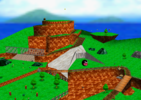
|
||
| Grassy fields surrounding a spiraled mountain. A battle is waged here between the peaceful Bob-omb Buddies and the enemy Bob-ombs. Once the battle is over, the Bob-omb Buddies allow Mario to access their cannons. There is a floating island in the east, and a barred cave towards the center with a Chain Chomp leashed in front of it. Unlock criterion: enter Mushroom Castle | ||
| 02. Whomp's Fortress |
Missions | |
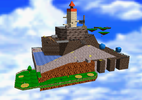
|
||
| A fortress in the sky. It is ruled by a Big Whomp who sits at the top of the fortress. The path leading to him has falling platforms and stone enemies. Once defeated, a climbable spire appears at the top. A chain of floating islands are in the northeast. They can we reached with the help of Hoot, a sleepy owl found in the course's single tree. Unlock criterion: collect a Power Star | ||
| 03. Jolly Roger Bay |
Missions | |
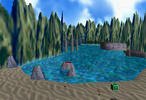
|
||
| A cove containing the wreck of a sunken ship. A giant moray eel nests in the ship and stirs when approached. An underwater corridor in the northwest leads to a cave that holds treasure chests. Solving the puzzle of the chests reveals a Power Star. Unlock criterion: collect 3 Power Stars | ||
| 04. Cool, Cool Mountain |
Missions | |
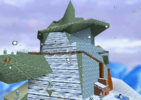
|
||
| A snow-covered mountain inhabited by penguins and snowpeople. Wooden bridges and moving gondolas are built into the side of the mountain. A cabin is near its peak. This cabin contains the Snow Slide, where Mario is challenged by a big belly-sliding penguin. Unlock criterion: collect 3 Power Stars | ||
| Bowser in the Dark World |
Missions | |
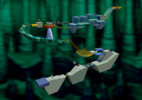
|
||
| A winding path in a cavernous void. The path bears Amps and shifting platforms. It ultimately leads to Bowser, who is fought on a circular platform surrounded by floating bombs. Unlock criterion: collect 8 Power Stars | ||
| The Princess's Secret Slide |
Missions | |
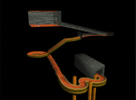
|
||
| A carpeted slide hidden on the mezzanine. Reaching the bottom of the slide gives Mario access to a Power Star - the first Secret Star available to the player. Reaching the bottom within 21 seconds awards him with a second one. Unlock criterion: collect a Power Star | ||
| The Secret Aquarium |
Missions | |

|
||
| A closed tank housing blue fish and Red Coins. Collecting all of them reveals a Secret Star. The aquarium is accessed through a little alcove in the same room that holds the painting for Jolly Roger Bay. Unlock criterion: collect 3 Power Stars | ||
| Tower of the Wing Cap |
Missions | |

|
||
| Towers in a sea of clouds. The turret in the middle holds the Wing Cap Switch that makes the Wing Cap permanently available in main courses once struck. Red Coins appear around the towers and can only be collected by Mario in his wing form. Unlock criterion: collect 10 Power Stars | ||
| The Castle Basement and Courtyard | ||
| 05. Big Boo's Haunt |
Missions | |

|
||
| The haunted house hidden in Princess Peach's courtyard. The rooms of the house contain ghosts and animated furniture that try to strike Mario. Navigation requires solving puzzles and memorizing patterns in the halls. Failing to do so often brings Mario to the house's flooded basement, where a spinning carousel filled with Boos can be found. Unlock criteria: clear Bowser in the Dark World, collect 12 Power Stars, and defeat the Big Boo that holds the miniature carousel in the courtyard | ||
| 06. Hazy Maze Cave |
Missions | |
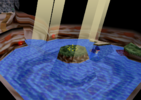
|
||
| An underground labyrinth filled with dead ends, traps, and bottomless pits. There are two floors. The first one has a large chamber in the southeast with a controllable elevator, hallways with rolling Boulders in the the northwest, and a maze with toxic clouds in the northeast. The lower floor leads to a pool that holds a friendly sea dragon. Unlock criterion: clear Bowser in the Dark World | ||
| 07. Lethal Lava Land |
Missions | |
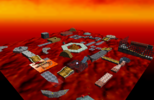
|
||
| Platforms in a lava sea. Some of them shift back and forth or can be manually rolled. They surround a small volcano that can be physically entered. Bullies appear in this course and will knock Mario into lava on contact. Sparkies and other fiery obstacles also appear that burn him when touched. Unlock criterion: clear Bowser in the Dark World | ||
| 08. Shifting Sand Land |
Missions | |
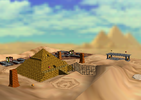
|
||
| Desert sands surrounding a pyramid. A condor flies through the sky here. Much of the course is covered in quicksand and steep dunes. Little tornados can be used to avoid obstacles. Narrow walkways are found in the northeast and a small oasis in the northwest. The pyramid can be entered, where a labyrinth leads to the stone boss, Eyerok. Unlock criterion: clear Bowser in the Dark World | ||
| 09. Dire, Dire Docks |
Missions | |
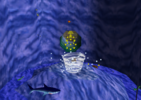
|
||
| Deep water. A whirlpool is at the center of the seabed and is circled by sharks and a manta ray. A corridor in the east leads to an wider area where Bowser has hidden a submarine. Unlock criterion: collect 30 Power Stars | ||
| Bowser in the Fire Sea |
Missions | |
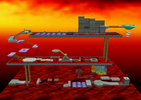
|
||
| Three narrow pathways surrounded by lava. Portions of the course gently rise and fall in lava, making traversal challenging. The pathway leads to the the second battle against Bowser. Unlock criterion: complete "Board Bowser's Sub" | ||
| Cavern of the Metal Cap |
Missions | |
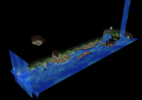
|
||
| An underground streambed that holds the Metal Cap Switch. Striking it makes the Metal Cap accessible in other courses. The water moves rapidly in this course. If Mario is swept up in it, he is brought to the Castle Grounds. Unlock criterion: clear Bowser in the Dark World | ||
| Vanish Cap Under the Moat |
Missions | |
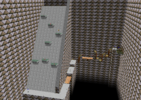
|
||
| A hidden area only accessible once the castle's moat is drained. When Mario enters the course he is in his vanish form, and he must navigate the course while the power-up is still in effect to access the Vanish Cap Switch. Striking it makes the Vanish Cap accessible in other courses. Unlock criteria: clear Bowser in the Dark World and drain the castle's moat | ||
| Upper Floors and Tower | ||
| 10. Snowman's Land |
Missions | |
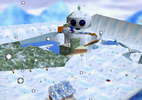
|
||
| A chilly land surrounding a giant Snowman. Slippery ice and freezing ponds occur in this course. Chill Bully occurs on a floating island of ice in the east. Narrow paths allow Mario to ascend the Snowman, but he will begin to blow gusts of air when he nears his head. An enterable igloo is near the base of the Snowman. Unlock criterion: clear Bowser in the Fire Sea | ||
| 11. Wet-Dry World |
Missions | |
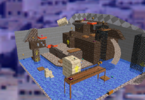
|
||
| A flooded, empty town. There are colorful switches at several locations in the town that cause the water level to rise or fall. There is a hidden Downtown area that can only be accessed through the cage in the southeast. Unlock criterion: clear Bowser in the Fire Sea | ||
| 12. Tall, Tall Mountain |
Missions | |
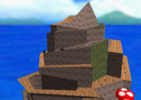
|
||
| A tall mountain surrounded by mushrooms high above the sea. Gusts of wind and the Fwoosh enemy make ascending the mountain challenging. The entrance to a secret slide can be found near the summit. Ukkikis live in this course, one of which attempts to steal Mario's cap. Unlock criterion: clear Bowser in the Fire Sea | ||
| 13. Tiny-Huge Island |
Missions | |
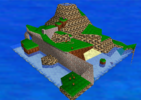
|
||
| An island that presents itself in two different ways depending on which painting it is accessed from in the castle. One is large with vast areas and giant versions of normal enemies. Mario can easily access the interior of this version of the island, which is home to Wiggler. The other is tiny with small enemies. Changing the terrain in one version of the island affects the other two and doing so is required to obtain all of its Power Stars. Unlock criterion: clear Bowser in the Fire Sea | ||
| 14. Tick Tock Clock |
Missions | |
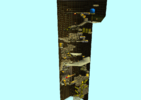
|
||
| A vertical obstacle course within the tower's clock. Moving platforms are found throughout the clockwork that can help Mario reach hidden alcoves or throw him back towards the bottom. The speed of these platforms (and whether they move at all) is determined by where the clock's hands are positioned when he enters the course. Unlock criterion: collect 50 Power Stars | ||
| 15. Rainbow Ride |
Missions | |
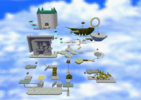
|
||
| Floating islands and moving platforms high in the sky. Magic Carpets travel along rainbows in large stretches of the course, one of which feeds through a floating palace. The Rainbow Cruiser can be found in the northeast. Unlock criterion: collect 50 Power Stars | ||
| Bowser in the Sky |
Missions | |
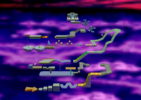
|
||
| A challenging obstacle course that leads to the final confrontation with Bowser. Some of the platforms on this course allow Mario to walk up walls if he maintains momentum while others shift under his weight. Bowser will start to break the arena he is fought on, leaving it in the shape of a five-pointed star. The reward for defeating him, the Jumbo Star, is not incorporated into Mario's total Power Star count. Unlock criterion: collect 70 Power Stars | ||
| Wing Mario Over the Rainbow |
Mission | |

|
||
| Clouds and checkerboard platforms in the sky. The platforms are bridged by rainbows. Unlock criterion: collect 50 Power Stars | ||
| Other | ||
| Mushroom Castle |
Missions | |
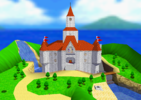
|
||
| Princess Peach's castle in the Mushroom Kingdom. Toads and MIPS are sealed inside the castle. Some of them will give Mario a Power Star when spoken to. The grounds around the castle is the first area of the game, and where Mario initially appears every time the player loads their save file. Unlock criterion: begin a new save file | ||
| Level chart information and legend: The main courses are designated with the unique number they are given in-game. Bowser, secret, and switch courses lack numerical designation and are listed as they appear in Pelland and Owsen (1996). Three symbols convey attributes about each course: | ||
Mushroom Castle
- Main article: Peach's Castle
Mushroom Castle is a connective space from which Mario can access the game's levels. It is a white-bricked palace with a red-tiled roof. Five towers are built into the castle: four at each corner and a large one in the center. Each one is topped with a spire, and the four outermost ones are also topped with a red pennant. A stained-glass portrait of Princess Peach is above the front doors, where Peach has been imprisoned by Bowser. The smaller windows on the castle are shaped like mushrooms. Mushroom Castle overall bears a superficial resemblance to a keep. It is framed as the place where Princess Peach lives in the Mushroom Castle and usually contains Power Stars for protection.[20]
The Castle Grounds is the first area in the game where the player takes control of Mario, and it is a risk-free environment for the player to familiarize themselves with his controls.[8][21][22][4][3] There are no enemies here, nor concrete objectives. While the player is directed to the castle in Peach's letter to Mario, nothing forces them to enter it, implicitly encouraging them to explore. The Castle Grounds is a grassy area with gently sloping hills, trees, picket fences, and a small lake that feeds into the castle's moat. Several readable boards are near Mario's starting position that detail his available actions, but they are not forced upon the player.
The castle's interior is divided into three sections analogous to the worlds of prior Super Mario games: a first floor and mezzanine; a basement and courtyard; and a second and third floor that leads to the central tower. With the exception of the basement, the castle's flooring has a checkerboard pattern and red carpeting. A hilly vista with a blue sky behind it is painted onto the walls. The basement is a flooded, dungeon-like area lit by torches that can burn Mario. One of the basement's corridors has a pair of stone pillars that, when Ground Pounded, drains the moat. The courtyard is a grassy space behind Mushroom Castle with a fountain at its center. It is filled with Boos, one of which contains a miniature carousel that holds Big Boo's Haunt. Among the courses of a section, Mario can typically play them in any order. There are some exceptions, such as at the start of the game, when only Bob-omb Battlefield is initially accessible.
Rather than list them individually on the pause menu, all Power Stars collected from Bowser courses, secret courses, and Switch courses are collectively listed as the castle's "Secret Stars", and, indeed, the secret and Switch courses are more well hidden than the main courses in the game. Finding them necessitates exploration and puzzle-solving within the castle's walls. For example, the only way to access Vanish Cap Under the Moat is by draining it, the means of which is never explicitly communicated in-game, but instead comes from comfortability with Mario's moves. The window that leads to The Princess's Secret Slide is not in the center of its room, departing from what is established in the other rooms that contain paintings and can only be found if the player deviates from what is established. This design principal permeates throughout the castle and often awards the player with 1-Up Mushrooms, hidden courses, or interactable elements.[8] Toads can be found inside the castle, where they will provide gameplay tips and words of encouragement when prompted. Some individuals will give Mario a Power Star when spoken to. MIPS, a yellow rabbit, can be found hopping around the basement once Mario has obtained a certain number of Power Stars (see chart above). He will give Mario a Power Star if caught.
In the majority of prior platform games, the player can select levels on a map-like menu with a cursor. The cursor itself may represent the player character, as is done in Super Mario Land 2: 6 Golden Coins (1992) and Super Mario World 2: Yoshi's Island, but the degree of control the player has on the cursor is more limited than they would have in the actual levels. Additionally, most world maps are structured in a way where completing one level unlocks a path to only one or two subsequent levels. Super Mario 64 instead has a fully interactive level as the "map", where Mario controls exactly the same as he does in the courses.
Notes and references
Notes
- ^ Private correspondence with shmuplations clarifies that the text they translated as "diorama" was written as 箱庭 (hakoniwa) in the original Shogakukan (1996) text.
References
- ^ a b c d Yoshiaki Koizumi. "Super Mario Galaxy: The Journey from Garden to Galaxy" (archived). Montreal International Games Summit. Jan 2007. Recorded by Eric St-Cyr. Compiled by Hover. YouTube, youtube.com. Published 24 Sep 2016. Accessed 27 Feb 2021.
- ^ a b 64編集部 (eds). スーパーマリオ64 マリオ・ザ・テクニック―完全攻略への最短ルート編 (Japanese source). Tokyo: Takarajimasha, 1996. ISBN: 978-4-79-661121-3. Cited in-text as Takarajimasha (1996).
- ^ a b c d shmuplations (translator). "Super Mario 64 – 1996 Developer Interviews" (English translations of Takarajimasha and Shogakukan, 1996). shmuplations.com. Published 2022. Accessed 22 Jun 2023.
- ^ a b Editing staff (eds). スーパーマリオ64 (ワンダーライフスペシャル―任天堂公式ガイドブック) (Japanese source). Tokyo: Shogakukan, 1996. ISBN: 978-4-09-102554-8. Cited in-text as Shogakukan (1996).
- ^ a b c Bill Trinen. "What's in a Box?". Nintendo Treehouse Log. Tumblr, tumblr.com. Published 14 Jun 2017. Accessed 30 Jan 2021.
- ^ Andrew R. Dean. "Chapter 8: The Courtyard Garden". Handbook, Part 1: Design & Craft (digital). North American Japanese Garden Association, najga.org. Published 10 Dec 2010. Accessed 24 Jun 2023.
- ^ Nihon Gaiji Kyōkai (eds). Contemporary Japan: A Review of Far Eastern Affairs. Tokyo: Foreign Affairs Association of Japan, (25): 246. Published 1957. Accessed 14 Aug 2023.
- ^ a b c d Design Doc. "What Makes a Great Hub World? - How Mario 64, Spyro, and Hades Made Theirs ~ Design Doc". YouTube, youtube.com. Published 12 Oct 2020. Accessed 18 Aug 2023.
- ^ a b Super Mario 64 Instruction Booklet. Großostheim: Nintendo of Europe, 1996. page 15.
- ^ Scott Pelland and Dan Owsen. The Super Mario 64 Player's Guide. Redmond: Nintendo of America, 1996.
- ^ a b c d Pelland and Owsen, page 46
- ^ Pelland and Owsen, page 44
- ^ Pelland and Owsen, page 45
- ^ a b c d e Pelland and Owsen, page 84
- ^ Pelland and Owsen, page 81
- ^ a b Pelland and Owsen, page 82
- ^ a b c d e f Pelland and Owsen, page 127
- ^ Pelland and Owsen, page 126
- ^ Pelland and Owsen, page 83
- ^ Pelland and Owsen, page 5
- ^ Rich Stanton. A Brief History Of Video Games: From Atari to Virtual Reality (digital). London: Little, Brown Book Group, 2015. ISBN: 9781472118813.
- ^ Christopher W. Totten. "Hub Spaces". An Architectural Approach to Level Design. Boca Raton: CRC Press, 2018. pages 133-135. ISBN: 9781351982924.
Image references
- ^ Mizu-chan. Miniature Japanese garden. Minato, Tokyo. 21 Jan 2014. Muza-chan's Gate to Japan, muza-chan.net.
